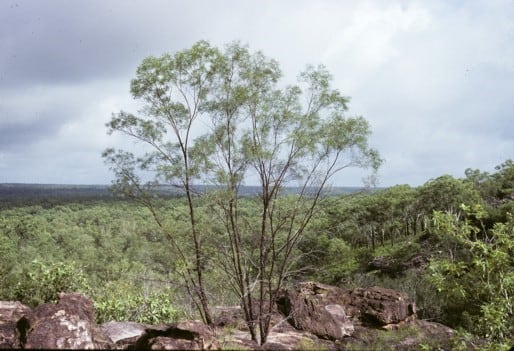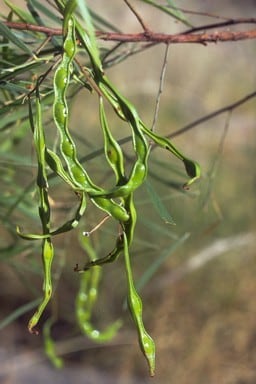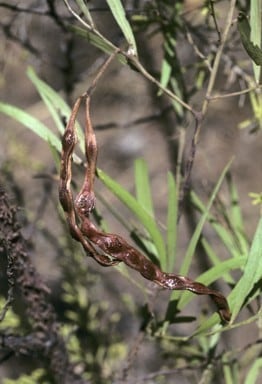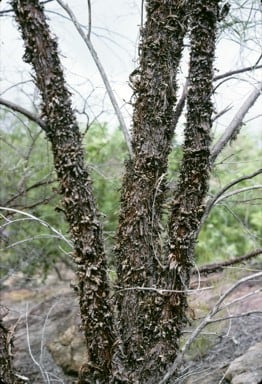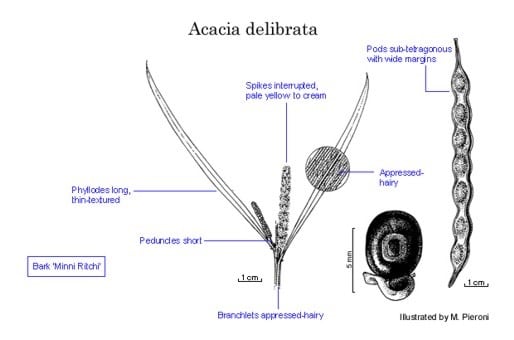Acacia delibrata A.Cunn. ex Benth.
WATTLE
Acacias of Australia
Family
Fabaceae
Distribution
Occurs in tropical W.A., on the offshore islands, and mainland ranging from 15ºS to 17ºS and 123ºE to 127ºE.
Description
Shrub or tree to 9 m high, resinous; trunk to 4.5 m high. Bark ‘Minni Ritchi’, red-brown. Branchlets angular to ±flattened near apices, very slender, dark red-brown; ridges light to dark red-brown, ±sericeous; interstices sericeous or ±glabrous, ±lenticellate. Phyllodes very narrowly elliptic to ±linear, flat, falcate, 6–14.5 cm long, 1.5–8 mm wide, thin; hairs weak, appressed on lamina or only on nerves; margins and base (young phyllodes pale yellow- to white-sericeous), with conspicuous midnerve and 1–3 semiprominent nerves on each side; minor nerves 3 or 4 per mm, occasionally anastomosing; gland 1, basal, to 1 mm above pulvinus. Spikes 1.5–3 cm long, delicate, pale yellow or cream-coloured. Flowers 5-merous; calyx 0.4–0.6 mm long, dissected for 1/3–2/3; upper calyx tube pubescent, with ciliolate margins; corolla c. 1–1.3 mm long, dissected for 1/2, papillose; ovary pubescent. Pods linear, submoniliform, often twisted, subtetragonous, 8–14 cm long, crustaceous, obscurely reticulate, ±glabrous; margins to 5.5 mm thick. Seeds longitudinal, rotund, 4–5 mm long, light brown to blackish; pleurogram with broad, yellowish halo; areole closed, round or elliptic, depressed, light brown to blackish.
Phenology
Flowers Apr.–June & Oct.
Habitat
Grows in stony soil over quartzite or sandstone, on plateaux, on the coast or along watercourses, in eucalypt woodland or in pure stands.
Specimens
W.A.: Sunday Is., W Kimberleys, W.V.Fitzgerald (MEL, NSW); 22 km SW of Mount Barnett Stn, E Phillips Ra., G.P.Guymer 572 (NE, NSW); Galvans Gorge, Phillips Ra., J.H.Willis & A.C.Beauglehole (MEL, NSW107765); Boongaree Is., Prince Frederick Harbour, P.G.Wilson 11338 (MEL, PERTH).
Notes
The illustrations of "A. delibrata" given in F.J.H. von Mueller, Iconogr. Austral. Acacia dec. 11: [pl. 1] (1888) are not this species. Although L.Pedley, Austrobaileya 1: 159 (1978) suggested that they represent A. torulosa it appears that the plate comprises elements of two taxa. The flowering specimen illustrated is possibly A. torulosa and the fruiting specimen is possibly A. oncinocarpa, but further study is needed to verify these determinations.
FOA Reference
Data derived from Flora of Australia Volumes 11A (2001), 11B (2001) and 12 (1998), products of ABRS, ©Commonwealth of Australia
Author
Dr M.D.Tindale and Dr P.G.Kodela with the assistance of M.Bedward, S.J.Davies, C.Herscovitch, D.A.Keith and/or D.A.Morrison
This identification key and fact sheets are available as a mobile application:
URL: https://apps.lucidcentral.org/wattle/
© Copyright 2018. All rights reserved.
